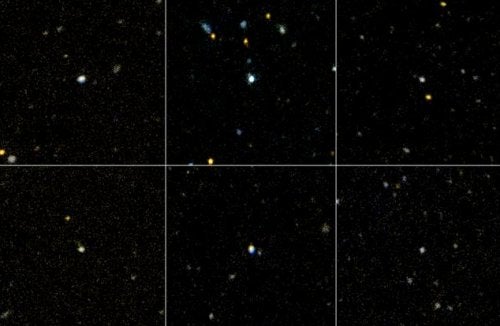Astronomers using NASA’s Galaxy Evolution Explorer (GALEX) satellite report finding dozens of small, massive galaxies 2 to 4 billion light-years away.
The newly found galaxies appear to be teeming with exploding supernovae and hot, young stars — two hallmarks of galactic youth. The astronomers estimate the galaxies span ages from perhaps as little as 100 million years to a billion years, making them newborns in galactic terms. The Milky Way is about 10 billion years old.
Says Tim Heckman of John Hopkins University, head of the team making the discovery, “These galaxies differ from mature galaxies like our own Milky Way by being extremely bright in ultraviolet light, and also by being quite compact.”
The discovery surprised the researchers because it told them today’s universe is still spawning massive, compact galaxies. “We knew there were really massive young galaxies eons ago,” says Chris Martin of Caltech, principal investigator for GALEX. “But we thought they had all matured into older ones like the Milky Way.”
“It’s like finding a living fossil in your own backyard,” adds Heckman, who is the lead author on the paper reporting the discovery; it will appear in The Astrophysical Journal Letters.
“The newborn galaxies,” Heckman continues, “differ from ordinary small galaxies nearby in that they’re forming stars at a prodigious rate — tens of times more than the Milky Way, which is a big galaxy, rich in gas — and hundreds of times more than a small galaxy.” For comparison, one small galaxy discovered recently, I Zwicky 18 (see related article below), shines only 1 percent as bright as the newfound galaxies in ultraviolet light — a telltale sign it belongs to a different class of galaxy altogether.
The newly discovered galaxies are fossils in another way, too. They’re comparatively free of the heavy elements needed for making planets and life. Heckman says, “The chemical properties of these newborn galaxies are consistent with the young galaxies from 10 billion years ago.”
This differs markedly from the Sun and planets, which represent a second-generation (or later) stage of star birth in the Milky Way. The heavy elements making up the solar system were forged in older, massive stars that scattered their debris into the galaxy ages ago.
Commenting on the discovery, theoretical astronomer Alice Shapley of the University of California, Berkeley, notes that while the newborn galaxies closely resemble young galaxies soon after the Big Bang, they raise questions of comparison. She asks, “Are these newborn galaxies really identical to the distant galaxies in the early universe? Or are they hiding older stars masked by the glare of the young stars producing such large amounts of ultraviolet light?”
Another unsolved puzzle concerns what is triggering the strong bursts of star-making in the newborn galaxies. Shapley wonders, “Why is this happening only recently instead of 10 billion years ago, when the Milky Way formed?”
It could be that a long-running process is approaching an end, replies Heckman. “We know the rate of galaxy formation declined strongly over the history of the universe, and, right now, we could be seeing the last dregs of galaxy birth, the last few stragglers.”
Where the newborns fit among the clusters and superclusters of galaxies is an unsolved issue, say the astronomers. “The sample we have right now is too small,” says Heckman. And, he notes, “These galaxies are far enough away that we don’t yet have detailed maps of their environments.”
To be true building blocks of larger galaxies, the newly found compact ones would need to collide with other galaxies or attract enough gas to grow. Heckman isn’t sure this will occur. “When the universe was young, there were many of these things,” so building larger galaxies though collisions and mergers was understandable. But lacking knowledge of the compact galaxies’ present surroundings, he says, “I think it’s less clear what will happen to these in the future.”
The next steps, the researchers say, are to continue GALEX’s ultraviolet survey to assemble a more complete picture — and to focus the Hubble Space Telescope on enough of these “living fossils” to gain a sense of their structure and composition.
Says Heckman, “These galaxies give us a chance to study how galaxies like the Milky Way form in an up close and personal way.”










